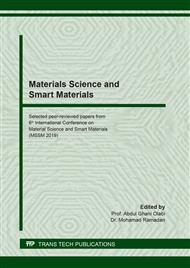[1]
L. Kunčická, R. Kocich, C. Hervoches, A. Macháčková, Study of structure and residual stresses in cold rotary swaged tungsten heavy alloy, Mater. Sci. Eng. A. 704 (2017) 25–31.
DOI: 10.1016/j.msea.2017.07.096
Google Scholar
[2]
D. Rittel, G., Weisbrod, Dynamic fracture of tungsten base heavy alloys, Int. J. Fract. 112 (2001) 87-98.
Google Scholar
[3]
D. Handtrack, B. Tabernig, H. Kestler, P. Pohl, W. Glatz, L.S. Sigl, Tungsten Heavy Alloys for Collimators and Shieldings, 18th International Plansee Seminar, Reutte, Austria, (2013).
Google Scholar
[4]
R. Kocich, L. Kunčická, D. Dohnalík, A. Macháčková, M. Šofer, Cold rotary swaging of a tungsten heavy alloy: Numerical and experimental investigations, Int. J. Refract. Met. Hard Mater. 61 (2016) 264–272.
DOI: 10.1016/j.ijrmhm.2016.10.005
Google Scholar
[5]
U. Ravi Kiran, J. Kumar, V. Kumar, M. Sankaranarayana, G.V.S. Nageswara Rao, T.K. Nandy, Effect of cyclic heat treatment and swaging on mechanical properties of the tungsten heavy alloys, Mater. Sci. Eng. A. 656 (2016) 256-265.
DOI: 10.1016/j.msea.2016.01.024
Google Scholar
[6]
N. Durlu, N.K. Caliskan, B. Sakir, Effect of swaging on microstructure and tensile properties of W-Ni-Fe alloys, Int. J. Refract. Met. Hard Mater. 42 (2014) 126-131.
DOI: 10.1016/j.ijrmhm.2013.08.013
Google Scholar
[7]
L. Kunčická, T.C. Lowe, C.F. Davis, R. Kocich, M. Pohludka, Synthesis of an Al/Al2O3 composite by severe plastic deformation, Mater. Sci. Eng. A. 646 (2015) 234–241.
DOI: 10.1016/j.msea.2015.08.075
Google Scholar
[8]
R. Kocich, M. Greger, A. Macháčková, Finite element investigation of influence of selected factors on ECAP process, in: Metal 2010 19th 19th international metallurgical and materials conference, Tanger Ltd., 2010: p.166–171.
Google Scholar
[9]
A.B. Naizabekov, V.A. Andreyachshenko, R. Kocich, Study of deformation behavior, structure and mechanical properties of the AlSiMnFe alloy during ECAP-PBP, Micron 44 (2013) 210-217.
DOI: 10.1016/j.micron.2012.06.011
Google Scholar
[10]
R. Kocich, L. Kunčická, A. Macháčková, Twist Channel Multi-Angular Pressing ( TCMAP ) as a method for increasing the efficiency of SPD, IOP Conf. Ser. Mater. Sci. Eng. 63 (2014) 12006.
DOI: 10.1088/1757-899x/63/1/012006
Google Scholar
[11]
R. Kocich, A. Macháčková, F. Fojtík, Comparison of strain and stress conditions in conventional and ARB rolling processes, Int. J. Mech. Sci. 64 (2012) 54–61.
DOI: 10.1016/j.ijmecsci.2012.08.003
Google Scholar
[12]
R. Kocich, A. Macháčková, L. Kunčická, F. Fojtík, Fabrication and characterization of cold-swaged multilayered Al–Cu clad composites, Mater. Des. 71 (2015) 36-47.
DOI: 10.1016/j.matdes.2015.01.008
Google Scholar
[13]
B. Katavić, Z. Odanović, M. Burzić, Investigation of the rotary swaging and heat treatment on the behavior of W- and γ-phases in PM 92.5W-5Ni-2.5Fe-0.26Co heavy alloy, Mater. Sci. Eng. A 492 (2008) 337-345.
DOI: 10.1016/j.msea.2008.05.021
Google Scholar
[14]
R. Kocich, L. Kunčická, P. Král, P. Strunz, Characterization of innovative rotary swaged Cu-Al clad composite wire conductors, Mater. Des. 160 (2018) 828–835.
DOI: 10.1016/j.matdes.2018.10.027
Google Scholar
[15]
R. Liu, Z.M. Xie, X. Yao, T. Zhang, X.P. Wang, T. Hao, Q.F. Fang, C.S. Liu, Effects of swaging and annealing on the microstructure and mechanical properties of ZrC dispersion-strengthened tungsten, Int. J. Refract. Met. Hard Mater. 76 (2018) 33–40.
DOI: 10.1016/j.ijrmhm.2018.05.018
Google Scholar
[16]
F.-Z. Wang, H. Zhang, B.-J. Ding, R.-H. Zhu, A thermionic tungsten cathode activated with nanothoria and prepared by swaging method, Mater. Sci. Eng. A. 336 (2002) 59–63.
DOI: 10.1016/s0921-5093(01)01969-4
Google Scholar
[17]
B. Beausir, J.J. Fundenberger, Analysis Tools for Electron and X-ray diffraction, ATEX - software, www.atex-software.eu, (2017).
Google Scholar
[18]
B. Verlinden, J. Driver, I. Samajdar, R.D. Doherty, Thermo-mechanical processing of metallic materials, Elsevier Ltd, Amsterdam, (2007).
Google Scholar
[19]
F.J. Humphreys, M. Hetherly, Recrystallization and Related Annealing Phenomena, 2nd ed., Elsevier Ltd, Oxford, (2004).
Google Scholar
[20]
C.-L. Chen, S.-H. Ma, Effects of Ni/Co ratio and mechanical alloying on characteristics and sintering behavior of W-Ni-Co tungsten heavy alloys, J. Alloys Compd. 711 (2017) 488–494.
DOI: 10.1016/j.jallcom.2017.04.037
Google Scholar


